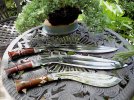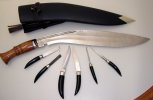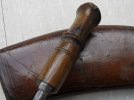- Joined
- Nov 19, 2012
- Messages
- 57
(While the khukuri mentioned has not been bought from Himalayan Imports, but a German importer, this seems to be place best suited for khukuris. If it is inappropriate, please tell me.)
So, I have bought a British Service No. 2. The helpful importer told me to choose this for a first khukuri since "the Brits know what they do". It does sound convincing, yet it is funny to learn that British Service is used more as a tool. For combat, the Gurkhas seem to bring their own. Here are the stats, and I am curious to learn about others:
Overall length: 390mm
Blade length: 268mm
Length on top: 283mm
Grip length: 110mm (without the brass)
Drop: 75mm
Belly: 45mm
Width at ricasso: 11mm
Width at belly: 8mm
Center of gravity: 77mm (from bolster, almost on the very edge)
Weight: 580g
Grip is made from buffalo horn; rat-tail tang; end of handle is is oval, but ending in two points. There is a small decorative knob on the end of the handle which I have excluded from the measurements.
So, I have bought a British Service No. 2. The helpful importer told me to choose this for a first khukuri since "the Brits know what they do". It does sound convincing, yet it is funny to learn that British Service is used more as a tool. For combat, the Gurkhas seem to bring their own. Here are the stats, and I am curious to learn about others:
Overall length: 390mm
Blade length: 268mm
Length on top: 283mm
Grip length: 110mm (without the brass)
Drop: 75mm
Belly: 45mm
Width at ricasso: 11mm
Width at belly: 8mm
Center of gravity: 77mm (from bolster, almost on the very edge)
Weight: 580g
Grip is made from buffalo horn; rat-tail tang; end of handle is is oval, but ending in two points. There is a small decorative knob on the end of the handle which I have excluded from the measurements.






